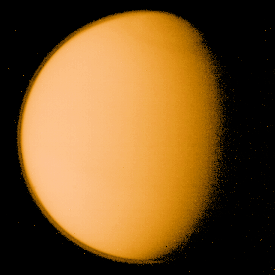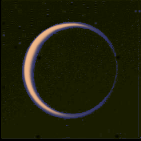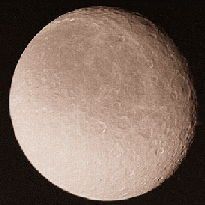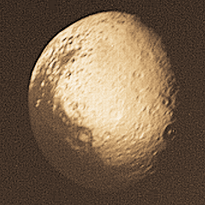
The following image shows a montage of 15 of Saturn's satellites (the current known number is 19). These range in size from Titan, the second largest moon in the Solar System (Ganymede is the largest), to small asteroid-like objects.

 Titan has an atmosphere.
This can be seen faintly in the image on the left as an outline, and more
clearly in the following image
Titan has an atmosphere.
This can be seen faintly in the image on the left as an outline, and more
clearly in the following image

taken by Voyager looking back at Titan and showing sunlight scattering in the atmosphere. The atmosphere of Titan has several layers of haze. It has a pressure at the surface of 1.6 times that of Earth, and is made up primarily of nitrogen, with about a 1% concentration of methane. The temperature on the surface is very cold, about -180 degrees Celsius. The atmosphere is extremely opaque because of thick smog that appears to result from sunlight interacting with hydrocarbons, much as smog forms on the Earth.
The clouds are probably composed of liquid nitrogen and methane drops, and it is speculated that Titan may be coverered with hydrocarbon lakes or oceans (specifically, methane and ethane). Although many of the organic chemicals thought to have been the precursors to life on Earth are present on Titan, it appears to be too cold for life as we know it to have evolved there. Here is a movie of infra-red images of Titan made with the Hubble Space Telescape. The structure shown in this animation represents heat variations in the atmosphere and surface of Titan.

Rhea |

Iapetus |
The preceding images show the satellite Rhea, which is seen to have many impact craters, and Iapetus, which has one side that is 10 times darker than the other. Other moons of Saturn include Mimas, which has an impact crater 1/4 the diameter of the moon, Enceladus, which may be geologically active because of tidal heating by Saturn, Tethys, which has a large flattened crater that is 1/2 the diameter of the moon and a very large canyon, and Dione, which is heavily cratered with ray structures associated with some craters.
Two small moons have been found to share Tethys's orbit, and one small moon shares Dione's orbit. This sharing of orbits had not been seen before the detailed investigation of Saturns system. Hyperion rotates chaotically because of the influence of Titan's gravity and a highly eccentric orbit. The outermost satellite, Phoebe, may be a captured asteroid.
Unusual Hubble View of Moons and Rings
 The adjacent
10 Hubble Space Telescope images capture several small moons
orbiting Saturn
while the Earth was just above the ring plane
and the Sun below it.
Moving out from Saturn, the
visible rings are: the broad C Ring, the Cassini Division, and the narrow F
Ring.
The adjacent
10 Hubble Space Telescope images capture several small moons
orbiting Saturn
while the Earth was just above the ring plane
and the Sun below it.
Moving out from Saturn, the
visible rings are: the broad C Ring, the Cassini Division, and the narrow F
Ring.
The first pair of images shows Dione, near the upper middle of the frames. Two smaller moons, Pandora (the brighter one closer to Saturn) and Prometheus, appear as if they're touching the F Ring. In the second frame, Mimas emerges from Saturn's shadow and appears to be chasing Prometheus.
In the second image pair, Mimas has moved towards the tip of the F Ring. Rhea, another bright moon, has just emerged from behind Saturn. Prometheus, the closest moon to Saturn, has rounded the F Ring's tip and is approaching the planet. The slightly larger moon Epimetheus has appeared.
The third image pair shows Epimetheus, as a tiny dot just beyond the tip of the F Ring. Prometheus is in the lower right corner. An elongated clump or arc of debris in the F ring is seen as a slight brightening on the far side of this thin ring.
In the fourth image pair, Epimetheus, in the lower right corner, streaks towards Saturn. The long ring arc can be seen in both frames.
The fifth image pair again captures Mimas, beyond the tip of the F Ring. The same ring arc is still visible.
In addition to the satellites, a pair of stars can be seen passing behind the rings, appearing to move towards the lower left due to Saturn's motion across the sky.
The images were taken Nov. 21, 1995, with Wide Field Planetary Camera-2 of the
Hubble Space Telescope
(Ref).
|
|